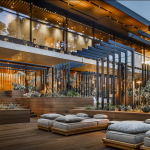The WA Museum Boola Bardip in Perth, Australia, designed by Hassell Studio and OMA, recently opened to the public, was conceived as a collection of stories about the diversity, that recall the rich history of contemporary culture of western Australia.
Historic buildings and new volumes have been linked to offer a variety of possibilities for art installations, to create the ‘city room’ and to host public cultural programmes, including a nine-day cultural festival celebrating the opening. The structure is three times the size of the old building, with eight permanent galleries and a temporary gallery for traveling exhibitions, next to training spaces, shopping areas and a cafe.
The historic buildings that are part of the museum include two mid-19th century structures called The Old Gaol and Jubilee Building, and the early 20th Century Art Gallery, Hackett Hall, and the Reading Room of the State Library. Their decorated facades, which have all been preserved, are in contrast to the new exhibition spaces that are enveloped by very modern openwork metal cladding and vast areas of stained glass. The perforated metal filters the light and makes the museum shine outward at night. Inside, the existing plant and new structures are connected through two intersecting circular structures. One that extends vertically and the other that wraps the buildings horizontally. These “rings” offer multiple routes around the museum and encourage visitors to explore and move freely within it. The name of the museum is characterized by the words Boola Bardip, which means “many stories” in Noongar – an Australian Aboriginal language spoken by the indigenous community in Western Australia.
Courtesy of AREA editorial office
Il WA Museum Boola Bardip a Perth, in Australia, progettato da Hassell Studio e OMA, recentemente aperto al pubblico, è stato concepito come una raccolta di storie sulla diversità, che richiamano la ricca storia della cultura contemporanea dell’Australia occidentale.
Edifici storici e nuovi volumi sono stati collegati per offrire una varietà di possibilità di allestimenti di opere d’arte, per creare la ‘city room’ e per ospitare programmi culturali pubblici, tra cui un festival culturale di nove giorni che celebra l’apertura. La struttura è grande tre volte la dimensione del vecchio edificio, con otto gallerie permanenti e una galleria temporanea per mostre itineranti, accanto a spazi per la formazione, aree commerciali e un caffè.
Gli edifici storici che fanno parte del museo comprendono due strutture della metà del XIX secolo chiamate Old Gaol e Jubilee Building, e la Galleria d’Arte dei primi del XX secolo, la Hackett Hall e la sala di lettura della Biblioteca di Stato. Le loro facciate decorate, che sono state tutte conservate, sono in contrasto con i nuovi spazi espositivi che sono avvolti da rivestimenti molto moderni in metallo traforato e vaste aree di vetrate. Il metallo traforato filtra la luce e fa brillare di notte il museo verso l’esterno. All’interno, l’impianto esistente e le nuove strutture sono collegate attraverso due strutture circolari che si intersecano. Una che si estende in verticale e l’altra che avvolge gli edifici in orizzontale. Questi “anelli” offrono molteplici percorsi intorno al museo e incoraggiano i visitatori a esplorare e a muoversi liberamente al suo interno. Il nome del museo è caratterizzato dalle parole Boola Bardip, che significa “molte storie” in Noongar – una lingua aborigena australiana parlata dalla comunità indigena nell’Australia occidentale.
Per gentile concessione della rivista AREA





